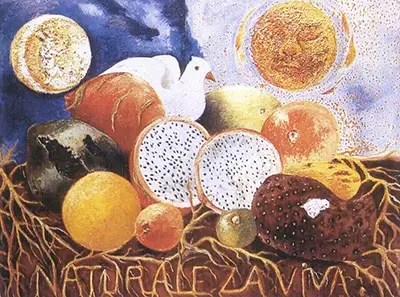A description of the painting
In this painting, Frida Khalo separated the sky into day and night. The painting also features images of both the sun and moon. This is a component exhibited in a lot of her compositions, especially at the time. The center of the painting is an image of a large white bird and a wide range of foods that grow from the earth. They are primarily foods sourced from the roots of various plants, like yams. However, Frida connected the foods directly to their roots. The roots are all connected in the ground to form the words "Naturaleza Muerta" which translates to Still Life.
The fruits in the painting depict the fruits that were present on her bedside table at the time. Frida made several other similar paintings depicting the things around her during her bedridden state. The use of color in the painting is a signature Frida Kahlo style.
The story behind the painting
Frida Khalo composed a lot of still life paintings for a lot of people in her fifties. At this time, she spent all her time in her house, unable to even get out of her bed because of the pain she was going through. At the time of this composition, Frida was recovering from her stay at the ABC hospital.
She commissioned the Living Nature to the actress Delores del Rio. Once she completed it, she also wrote a letter to the actress asking her to give her the payment she had promised beforehand kindly. She also indicated that the actress was to pay her a sum of 1000 pesos for the painting. Frida Kahlo also revealed that she desperately needed the money to repay the debt she owed the doctors and cover other medical bills in the letter. She requested that Delores sent the cash to Diego's assistant when he took the painting to her. However, her patron, Diego Rivera, did not take well to the letter. When he learned about it, he was extremely annoyed and asked to send the money back to the actress immediately. He also apologized to Delores on Frida's behalf.
Conclusion
The painting is currently located in Mexico City, Mexico, as part of the Maria Felix Collection. It is one of the most critically acclaimed paintings by Frida Kahlo.

